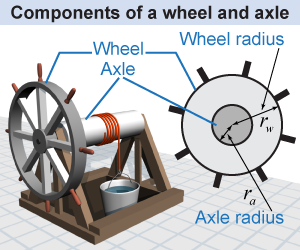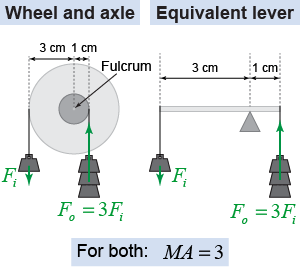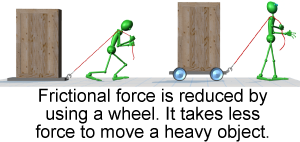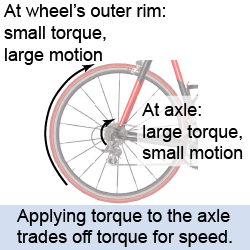|
 The invention of the wheel around 4,000 BC was a major advance in the development of civilization. What about the physics of wheels makes them so useful? Consider a wheel turning a drum to raise a bucket of water. The radius of the wheel is larger than the radius of the drum. The difference in radius creates a mechanical advantage. A small input force applied to turn the outer rim of the wheel creates a larger output force on the rope.
The invention of the wheel around 4,000 BC was a major advance in the development of civilization. What about the physics of wheels makes them so useful? Consider a wheel turning a drum to raise a bucket of water. The radius of the wheel is larger than the radius of the drum. The difference in radius creates a mechanical advantage. A small input force applied to turn the outer rim of the wheel creates a larger output force on the rope. 
|
 The physics of a wheel and axle is similar to that of a first-class lever, for which the center of the axle acts as the fulcrum. The input force is typically applied to the outer rim of the wheel, while the output force is exerted on the outer rim of the axle. The mechanical advantage is the ratio of the wheel radius (input arm) to the axle radius (output arm). In the example the axle radius is 1 cm and the wheel radius is 3 cm giving a mechanical advantage of 3. In actual wheels the ratio is much larger. The radius of a typical bicycle wheel is 35 cm while the axle radius is 0.4 cm, making a mechanical advantage of 87.5!
The physics of a wheel and axle is similar to that of a first-class lever, for which the center of the axle acts as the fulcrum. The input force is typically applied to the outer rim of the wheel, while the output force is exerted on the outer rim of the axle. The mechanical advantage is the ratio of the wheel radius (input arm) to the axle radius (output arm). In the example the axle radius is 1 cm and the wheel radius is 3 cm giving a mechanical advantage of 3. In actual wheels the ratio is much larger. The radius of a typical bicycle wheel is 35 cm while the axle radius is 0.4 cm, making a mechanical advantage of 87.5! 
|
| (12.5) | | | MAwa | = | mechanical advantage | | rw | = | wheel radius (m) | | ra | = | axle radius (m) |
| Mechanical advantage
of a wheel and axle |
|
 Wheels greatly reduce the force needed to overcome friction when pulling heavy objects. Consider sliding a crate along the floor. You have to apply a force equal to or greater than the friction force between the bottom of the crate and the floor. With a wheel, the coefficient of rolling friction is much lower. There are high forces at the small contact area where the axle is supported in the cart. Although sliding friction occurs in this place, the contact area is small, protected, and can be lubricated to reduce friction.
Wheels greatly reduce the force needed to overcome friction when pulling heavy objects. Consider sliding a crate along the floor. You have to apply a force equal to or greater than the friction force between the bottom of the crate and the floor. With a wheel, the coefficient of rolling friction is much lower. There are high forces at the small contact area where the axle is supported in the cart. Although sliding friction occurs in this place, the contact area is small, protected, and can be lubricated to reduce friction. 
|
 It is also possible to apply the input force closer to the axle, rather than at the rim of the wheel. This causes the output force to be smaller than the input force. This is the case with the bicycle. When you ride a bicycle, the input force applied by the chain to the axle turns the rear wheel. A small motion at the axle produces a large motion on the outer rim of the wheel. The bicycle’s use of the wheel and axle trades force for speed. You can pedal slowly, yet you still travel fast!
It is also possible to apply the input force closer to the axle, rather than at the rim of the wheel. This causes the output force to be smaller than the input force. This is the case with the bicycle. When you ride a bicycle, the input force applied by the chain to the axle turns the rear wheel. A small motion at the axle produces a large motion on the outer rim of the wheel. The bicycle’s use of the wheel and axle trades force for speed. You can pedal slowly, yet you still travel fast! 
|
Give two examples of the wheel and axle where the force is applied at the wheel.
 |
Answers will vary. Sample answers include a steering wheel, a ship’s wheel, and a water wheel. 
|
Give two examples of the wheel and axle where the force is applied at the axle.
 |
Answers will vary. Sample answers include an automotive wheel and an electric mixer. 
|

